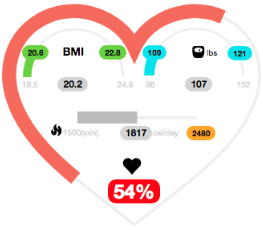
"Some things are worth the fat and calories, although I have to watch it like a hawk" - Megyn Kelly
Many of us are eating too much and not being active enough. This is why nearly two-thirds of the adult population is overweight or obese in developed countries. Switching from high-calorie to low-calorie, reducing portion size or skipping one or two high-calorie foods a day can be a good way to start cutting down calories.
Interestingly, exercise, besides being extremely good for your health, can also help you cut down calories directly from your body. Here are some recommendations to cut down on your daily calorie intake and eventually help you to reach your Ideal Weight.
Eating fewer calories does not necessarily mean eating less food. To be able to cut calories without eating less and feeling hungry, you need to replace some higher calorie foods with foods that are lower in calories and fill you up. In general, these foods contain a lot of water and are high in fiber. Think about what you eat and drink every day and try to identify those high-calorie foods that you could easily cut out.
Taking action
Switching from high- to low-calorie foods
Simple substitutions can make a big difference. For example, you could switch your creamy flavoured latte in the morning (250 cal) for a sugar-free expresso (0 cal) or your buttered toast (250 cal) for a low-fat yogurt (50 cal). Or you could easily save 60 calories by drinking one glass of fat-free milk (90 cal) instead of whole milk (150 cal). Instead of having a second slice of pizza (350 cal extra), get some fresh fruits (90 cal), saving 260 cal. Or switch your one glass of ice lemon tea (200 cal) for sparkling water (0 cal).
Reducing portions
The sizes of your portions affect how many calories you are accumulating. Twice the amount of food means twice the number of calorie intake. It is common to most of us to underestimate how much we are actually eating, especially if eating outside. Controlling our portions is a good way to control our calorie intake. For example, reduce your 8 ounces orange juice (110 cal) for 4 ounces (55 cal) or your 6-inch buttermilk pancake (175 cal) for a 4-inch diameter (85 cal) or your 1 1/2 cups of whole-grain spaghetti (260 cal) for 1/2 cup (85 cal).
You can also try these tips to control portion sizes and cut down many consumed calories: Go small. At the beginning of your meal, start with slightly less than what you feel like you want to eat. You can have it later if you are still hungry. Eat from plates, not from packages. Eating directly from a plastic bag or container gives you no sense of how much you are actually eating. Eating on a plate or in a bowl makes you aware of how much you are really eating. Use a small plate or bowl.
Skipping meals
Skipping meals like a whole breakfast or dinner may be not only ineffective in the goal of weight loss, but when meals are regularly skipped for a long period of time, it can actually lead to weight gain. It can be not only unhealthy, but it can actually damage your metabolism beyond repair. However, an alternative to skipping the whole meal can be actually to skip only parts of it. For example, you could try to skip (0 cal count) your beer (180 cal) at lunch (or switch it for water) or skip the ice cream (285 cal) you use to have in the afternoons. If skipping one of your favourite meals lead you to craving, then try to reduce its portion or substitute it for a low-calorie option as explained above.
Exercise
For a successful long-term weight management plan, it is very important that you also increase your physical activity. Combining regular activity and healthy eating will best help you to achieve and maintain a healthy weight. Exercise cut (eliminate, remove, burn) calories directly from your body.
Other recommendations
- Setting smart goals. Before starting to cutting calories down it is important that you know exactly what you want to achieve. One-click-to-Health tool/app can help you setting both your calorie goals and Ideal and Healthiest weight.
- Check out food labels. Try to check the nutrition information for the serving size and number of calories per serving. You may find that the small bag of chips you eat with lunch every day, for example, is two servings, not one, which means twice the calories you thought. Read Virtual Personal Trainer's food labels article
- Use a calorie counter. Check out reputable resources that offer tools or apps to track your calorie intake, such as websites or smartphone applications.
- Break down calories into nutrition needs. Cut down calories following some nutrition guidelines.
Related links
Do you want to be part of an experimental health program?
We encourage you to test what has been discussed on this blog by yourself and let us know about your experience, your progress and achievements in the comments section below. The results of these experimental program will be presented at international conferences and hopefully published in high impact medical and scientist journals. Your involvement and interaction as well as your contribution is important for us since the information and voluntary donations you provide will be further used for adapting, modifying and improving our programs.
Important notice
This Online Training approach is recommended for healthy adults only. This site is not intended for use by minors or individuals with any type of health condition. Such individuals are specifically advised to seek professional medical advice prior to initiating any fitness or nutrition effort or program.
Recommended articles









